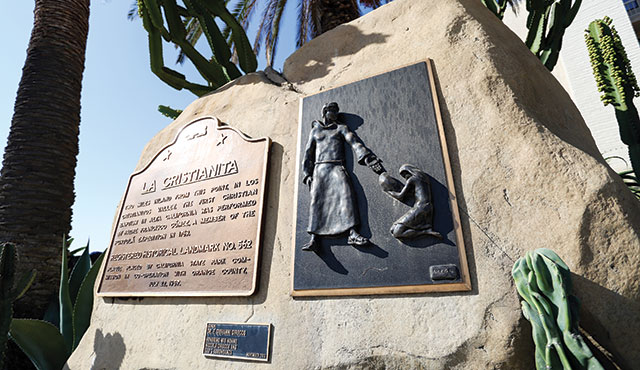The circumstances of the first recorded Catholic baptisms in California may be largely overlooked in history books, but they were once the stuff of pageantry in San Clemente – literally.
This year represents the 250th anniversary of the July 22, 1769 baptisms of two gravely ill infant native Acjachemen, later called Juaneno, girls by Padre Francisco Gomez of the famed Portola expedition.
For decades, San Clementeans commemorated the historical event through outdoor costumed reenactments, or pageants, performed by local community theater groups and actors. In different iterations and locations, “La Cristianita,” the name given by soldiers to the original site, and later “The Cross and the Arrow, Pageant of La Cristianita,” were performed between 1954-1988.
However, since the pageants ended, except for the moving of a historic monument, little has been done to recognize the seminal moment. And to some in the Catholic community, this is an oversight.
“The history of the evangelization of Alta California would be incomplete without marking and celebrating the pivotal beginning of that mission with the baptism of the first Christian by Fr. Gomez, a member of the now-famous Portolá expedition of 1769,” said Monsignor Arthur Holquin, pastor-emeritus of Mission Basilica San Juan Capistrano. “Like the biblical small seed, planted and nurtured, that humble beginning of the Gospel in our land would eventually, in God’s providence, flourish to be the Catholic Church of today in our million-plus Catholic family of rich diversity in the Diocese of Orange.”
Although the Portola expedition, which planted church and Spanish colonial claims from San Diego to San Francisco, and the involvement of Fr. Junipero Serra as the religious leader of the journey are well documented, recognition of the baptisms flew under the radar.
That ended in 1929 when San Clemente’s first mayor, Thomas F. Murphine, and Father St. John O’Sullivan, of the San Juan Capistrano Mission, wrote to the Orange County Historical Society about the occurrence and started the ball rolling.
In 1957, the first historic marker commemorating the baptism was placed near the original site at Camp Pendleton.
Late City Councilwoman Bertha Henry Taylor helped keep the event in the public consciousness, supporting the summer pageant. She was also a leading advocate to have a historical marker moved from City Hall in San Clemente to Casa Romantica for greater visibility. The relocated historical marker was unveiled in 2013.
However, the marker is only known to a few.
Ruth DeNault, president of the board for the nonprofit Casa organization, said few visitors are aware of the monument and she’s eager to let people know the plaque is on the Casa property.
“It’s right in our front yard and visible to all,” she said.
When the marker was moved to the new site, its importance was noted by Teresa Romero, chairwoman of the Juaneño band of Mission Indians.
“What this monument represents is the biggest paradigm shift in our culture – the day the children were baptized and we became Christians,” Romero told the OC Register at the time.
The first baptism
The Portola expedition was the first documented extensive exploration on inland California and was used by Spain to bolster its claim to large portions of California and the Pacific Northwest that were “discovered” in 1542 by the seafarer Juan Rodriguez Cabrillo.
The expedition was just over a week into its journey from San Diego when it came across a spring on the outskirts of San Clemente. While setting up camp, two priests, fathers Juan Crespi, the official diarist of the journey, and Gomez, were first told of one, then two dying girls nearby.
In his journal, Fr. Crespi wrote that the priests hurried to where the children were.
“Father Francisco Gomez baptized the child as well as he could with her clutched to her mother’s breast; she was named Maria Magdalena, and I have no doubt she will die and we have come just in time that this soul may go to Heaven,” Crespi wrote, as translated by Richard F. Pourade in his book “The Call to California.”
Crespi later baptized the second child naming her Margarita and the soldiers called the place Los Cristianitos.
“So merely by passing by, we have gained these two souls,” Crespi wrote.
As the expedition was moving on, it is unknown and seems unlikely the girls survived.
Fr. Serra, who was 55 at the time and the religious leader of the expedition, sometimes incorrectly receives credit for the baptisms. However, he remained in San Diego to establish the mission there while recovering from illness.
According to Pourade’s book, “It was not until some time afterward that Father Serra learned that Crespi and Gomez had performed the first baptisms in Alta California. To his dying day Serra would regret that the honor had not fallen to him.”
Fr. Serra was canonized as St. Serra by Pope Francis September 23, 2015. He was beatified by Pope John Paul II in 1988. The cause for beatification began in 1934 in Northern California.

